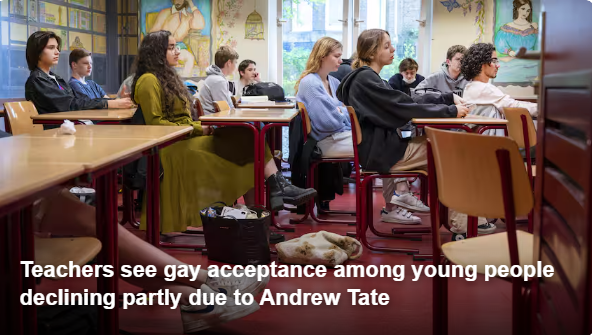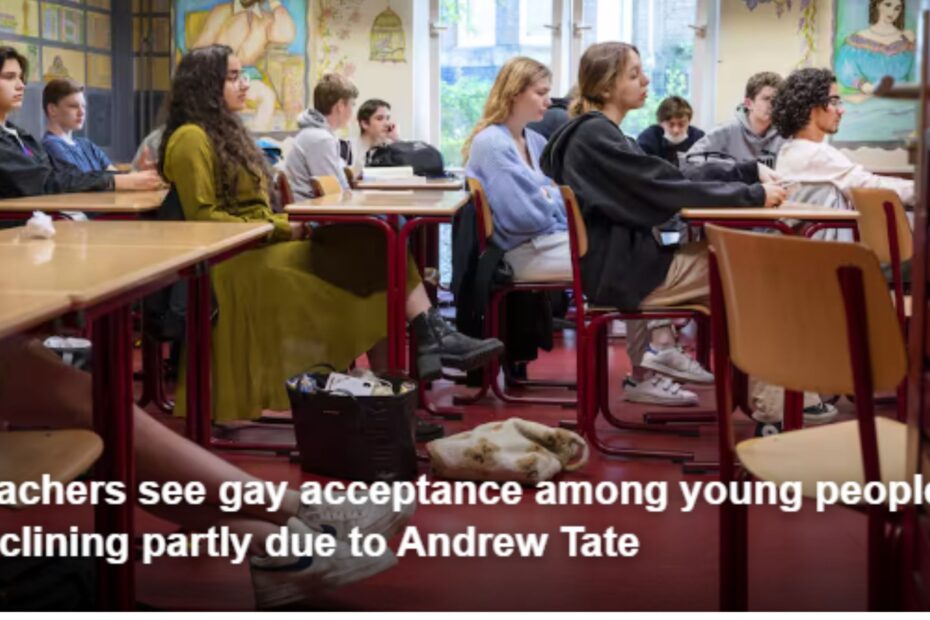It seems that fewer and fewer high school students find homosexuality normal. That is the impression given by the GGD Health Monitor , which was carried out in various regions. These signals are also being picked up in education. What is going on in the classroom and how do schools deal with this?
In seven of the eight regions in which the GGDs asked secondary school students about acceptance of homosexuality and bisexuality, it has decreased.
Read More : Summer guests 2024 with Sana Valiulina
See More : https://heylink.me/sabrina-zahira
In the Amsterdam region, acceptance among young people has dropped from 63 percent to 43 percent in four years. The drop was greatest in the Gooi en Vechtstreek : from 78 percent to 49 percent.

Social studies teacher and dean Robin Mobron of the Keizer Karel College in Amstelveen has been experiencing the turnaround for a number of years. “The change is particularly noticeable among boys between the ages of twelve and fifteen,” Mobron tells NU.nl.
“We see that they are infected by social media. That started a few years ago with influencer Andrew Tate, but this group now also watches videos of, for example, Forum voor Democratie leader Thierry Baudet.”
“You hear a kind of algorithmic bleating.”
-Robin Mobron, social studies teacher-
These videos include hateful remarks about homosexuality and gender identities. “They are short videos without any explanation or depth. You notice that young people are repeating them one-on-one. A kind of algorithmic bleating,” says Mobron.
How does he, as a teacher, engage in conversation with students? “Of course we ask about the deeper motives behind the hatred. But having a conversation is difficult, because young people often cannot substantiate their statements.” According to him, there is a kind of general hostility.
‘Every teacher should be able to engage in conversation with students’
The Dutch Association of Social Studies Teachers (NVLM) recognizes this image, says chairman Marcel Mooijman. “We are increasingly being asked by social studies education to pay attention to how teachers can discuss inclusivity and polarizing topics in the classroom.”
The association offers advice in this regard. “First of all, we provide the preconditions for conducting a good conversation: determine the tone of the conversation and let everyone have their say. In addition, good information is needed to be able to change your opinion. Many extreme remarks arise from ignorance. But changing your opinion takes time for every person,” Mooijman explains.
The task of having these conversations cannot be the sole responsibility of social studies teachers, he believes. “Hateful remarks occur everywhere at school: in the schoolyard, during math class and in the gym. When something like this happens, every teacher should be able to engage in constructive conversation with students,” the chairman states.
‘I had hoped that we would be further along in 2024’
Interest group COC Nederland provides information lessons on sexual diversity at schools. Thijs Smeenk is one of the educators and he too is increasingly noticing the lack of acceptance. “When I started this in 2012, I had hoped that we would be further along by 2024. But the hostility is only increasing.”
“I sometimes get asked: what if I feel like a dog?”
-Thijs Smeenk, spokesperson COC Netherlands-
Where does he think it comes from? “In addition to the influence of social media, the subject has also become broader. Previously, it was mainly about l, h and b, now it is about many more identities in the lhbtqia+ community. That creates resistance. During lessons, comments are sometimes made such as: ‘What if I feel like a dog, what do you say?’ When I then ask whether they think that classmates dare to speak out safely about, for example, their sexual orientation, they often realize that this will not be the case.”
COC spokesperson Philip Tijsma calls the figures from the GGDs very worrying. “Polarization is a global problem and is also penetrating into the classroom. We would very much like State Secretary Mariëlle Paul, responsible for primary secondary education and emancipation, to conduct further scientific research. What exactly is going on and what can we do about it? Ultimately, everyone at school should be able to be themselves and feel safe.”
‘Sometimes hateful comments are teenage behavior’
Tijsma: “We do have the impression that the hateful comments are sometimes also adolescent behavior: acting tough, shouting something loudly and seeing what the effect is. If you ask further and can refute untruths, it turns out that the soup is often not eaten as hot as it is served. That is a nice thought, but we still have to take this development very seriously. The LGBTQIA+ community certainly does not have it easy in secondary school.”
Teacher Mobron also thinks that it is mainly a question of age. “From the age of sixteen, the extreme remarks decrease”, he sees at his school. This seems to correspond with the results of the study Sex under 25 , conducted by Soa Aids Nederland and Rutgers. For this, a broader age group (between 13 and 25 years) was asked about the social acceptance of sexual and gender diversity. These results actually show an increasing acceptance.
So things seem to be getting better as high school students get older. But Mobron does have a caveat: “We have to be careful of the small group that doesn’t grow out of the hate. That can become dangerous.”
Studies show different results
GGD Health Monitor Youth
More than 188,000 pupils from the second and fourth year of secondary school participated in the GGD Health Monitor in the autumn of 2023. This research is conducted every four years in the Netherlands. In 8 of the 25 GGD regions, questions were asked about the acceptance of homosexuality. In seven regions, this acceptance appears to have decreased. Only in North and East Gelderland a slight increase of 2 percent can be seen.
Sex under the age of 25
In 2023, Soa Aids Nederland published the study Sex under 25 together with Rutgers . More than ten thousand young people between the ages of 13 and 25 completed the questionnaire. Young people were recruited via secondary schools and a sample from the Statistics Netherlands (CBS) database. The study shows that social acceptance of sexual and gender diversity has increased among respondents.

Pingback: What is a Website? This is the Definition of Website and Its Types - smartoobiz.com